- Hearing Assessments
- AUDIOGRAM
Audiology – The Measurement of Hearing
Hearing is measured by determining how well a person can hear a range of frequencies of sounds. There is a specific procedure used to gather this information, which then is generally plotted on a graph called an audiogram.
To the right is a sample audiogram form:
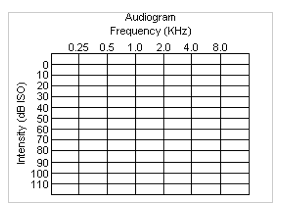
Across the top of the audiogram are numbers representing various frequencies of sounds that are typically tested. Low frequency sounds are represented on the left side of the audiogram, while high frequencies are on the right. Frequencies are measured in hertz (Hz), or kilohertz (KHz). This audiogram form depicts frequencies in KHz. The range of frequencies on the audiogram corresponds to the range of frequencies most needed for verbal communication purposes. Occasionally intermediate frequencies of 0.75, 1.5, 3 and 6 KHz may also be tested and plotted.
Going from the top to the bottom of the audiogram is the intensity scale in decibels (dB). “ISO” refers to the International Standards Organization which is a worldwide association that sets standards for a wide range of physical measurements. Softer sounds are represented at the top of the audiogram, while loud sounds are at the bottom. The actual values plotted on an audiogram at the different frequencies are called thresholds. A threshold is defined as the intensity at which a person can hear a specific sound 50% of the time. There is a standardized procedure to determine thresholds.
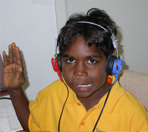
Generally an audiogram will show the hearing results for both the right and left ears. As such there are different symbols used to differentiate the hearing results for each ear. However, before proceeding with this topic, two other concepts need to be introduced.
Air and Bone Conduction Testing
Air and bone conduction testing is used to establish the type of hearing loss present. A hearing loss can be sensorineural, conductive or mixed.
Air conduction testing is done using standard earphones, although sometimes an insert phone is used. Basically, air conductive testing assesses the outer, middle and inner ear as a unit. On the other hand, bone conduction testing uses a bone vibrator, which is placed on the mastoid prominence behind the pinna. The bone vibrator transmits sounds to the bones of the skull, which in turn stimulate the inner ear directly. Basically, bone conduction testing assesses inner ear function. Comparison of the air and bone conduction thresholds is used to determine the type of hearing loss.
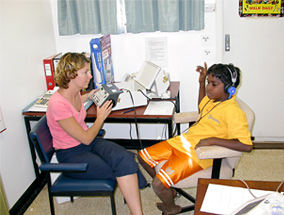
Masking:
There are certain circumstances that arise during air and bone conduction testing where the non-test ear may hear the stimulus presented to the test ear. This situation can result in an erroneous interpretation of the test results. Masking of the non-test ear is a technique used to eliminate the possibility of the non-test ear hearing the stimulus. Masking is necessary if there is a 40 dB difference in the air conduction threshold of the test ear and the bone conduction threshold of the non-test ear. An unmasked signal of a high enough intensity presented to the test ear can “cross over” and be heard by the non-test ear. Masking is almost always necessary when testing bone conduction. Bone conducted sounds are transmitted equally by the bones of the skull to both ears. There are a few situations when masking for bone conduction does not need to be used, or cannot be used. It is beyond the scope of this manual to engage in a comprehensive discussion of masking. The masking concept is introduced in order for one to recognize masked audiometric signals plotted on an audiogram and to be able to interpret the audiogram accordingly.
Audiometric Symbols:
In order to differentiate test results from the right and left ears, and whether plotted thresholds have been masked or not, a series of standardised audiometric symbols have been developed. Occasionally the symbols will also be color coded, with red representing the right ear, and blue the left.

Any of the above symbols with an arrow, down and to the left for the right ear or down and to the right for the left ear attached to it means that there was no response at that frequency.
Most audiograms will contain a key to the audiometric symbols.
Audiogram Interpretation:
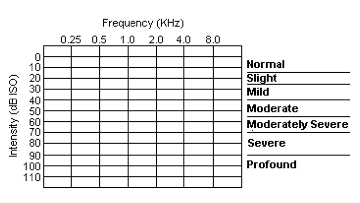 The information contained on an audiogram allows the determination of the degree and type of hearing loss. For verbally reporting the degree of hearing loss, there are standardized descriptive terms that are used.
The information contained on an audiogram allows the determination of the degree and type of hearing loss. For verbally reporting the degree of hearing loss, there are standardized descriptive terms that are used.
The following figure illustrates these terms and ranges of hearing loss associated with them:
Types of hearing loss
There are three types of hearing loss, sensorineural, conductive and mixed.
By definition, a sensorineural hearing loss is present if there is less than a 15 dB difference between the air and bone conduction thresholds of a given ear, and the air and bone conduction thresholds are worse than 15 dB. A conductive hearing loss is defined by bone conduction thresholds being 15 dB or better than the air conduction thresholds, and the bone conduction thresholds are 15 dB or less. And a mixed loss will have both conductive and sensorineural components in the loss.
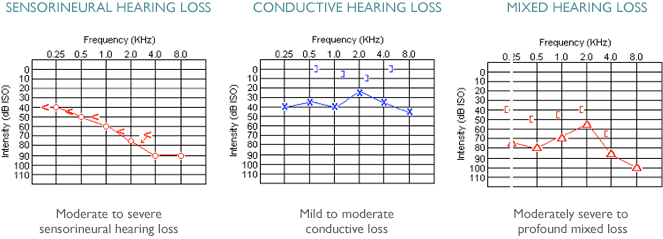
Call us today on (08) 9389 1622 or head to our Contact Us page and send us a message via the website.